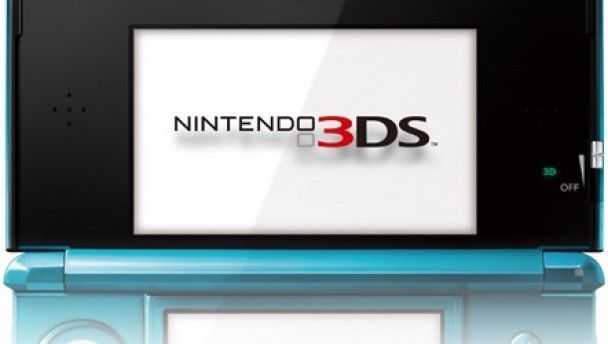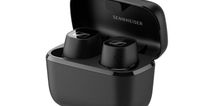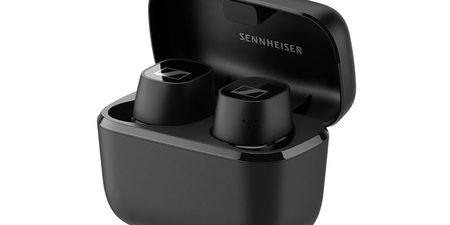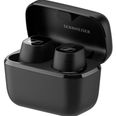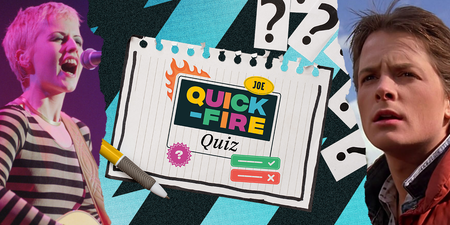The Nintendo 3DS has finally hit the shelves and we at JOE have spent hours testing the glasses-free 3D handheld. Here’s what we thought of it.
With all due respect to the Microsoft Kinect and Playstation Move peripherals, it’s been many years since gamers have experienced a proper hardware launch. Today marked the European release of the Nintendo 3DS, the Japanese giant’s ambitious, not to mention eye-wateringly expensive, follow-up to the Nintendo DS, a console which currently stands as the second biggest-selling of all time.
Like any console launch, the 3DS has featured last-minute retail price wars, fanatical midnight openings and as always, a new Ridge Racer title. We’ll be providing plenty of launch titles reviews in the coming days but for now, we wanted to test out the console’s 3D capabilities, battery life, build quality and multitude of in-built software.
If you’re still on the fence as to whether you’re ready to experience Nintendo’s much-vaunted glasses-free 3D technology this weekend, allow our review to be your guide as to whether the 3DS is a revolution in gaming or charming but unessential luxury.
Hardware
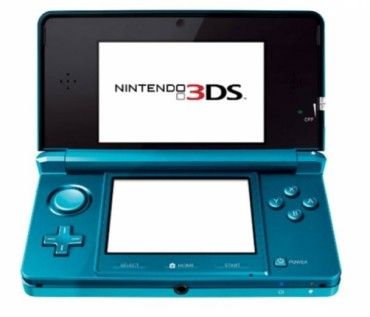
Aqua Blue – surprisingly less girly when seen in the flesh
Despite pre-release shots that showed a red model, the 3DS is shipping in two distinct colourways – Aqua Blue (above) or Cosmos Black. As you can see above, the upper screen of each iteration is black, as Nintendo believes that any other colour detracts from 3D effect of the top half of the console.
The top half of the 3DS features a unique and essential 3D slider (seen right), which allows you to adjust the impact of the 3D effect. The greater the effect, the greater the drain on the battery, while the slider can even be brought down to regular 2D if you wish.
We recommend that unless absolutely necessary for in-built software (Face Raiders, AR Games), there’s no need to utilise 3D for the console’s regular menus. We’re happy to see that the upper screen has been given a widescreen makeover, though like their predecessors, both screens tend to smudge quite easily.
The bottom half of the 3DS has undergone the biggest change, largely for the better. The biggest revelation is the slide pad, which sits above a new D-pad, which we found quite clicky and less comfortable than the previous DS.
As for the circle pad, one wonders quite how much it would have benefited Super Mario 64 DS and any other ambitious DS titles. The pad quickly becomes second nature and is our preferred method of control, even for 2D fighters such as Super Street Fighter IV: 3D Edition.
The left-hand side of the lower 3DS half contains a 2G SD card slot (already slotted in upon purchase) and volume control, while the right side is a wireless toggle. We should mention that the X, Y, B and A buttons aren’t quite as raised as their predecessors, which is a minor complaint.
The most surprising decision is that the Select, Home and Start buttons have been placed below the lower screen, though thankfully they respond to click rather than slight stylus gestures. Their positioning isn’t ideal however and we feel games that utilise the lower screen, particularly in heated situations (SFIV battles for example), may lead to accidental presses. As such, don’t be surprised if the next iteration of the console alters their placing.
In all, however, the console has a bulky, reasurringly expensive feel, while the glossy colourways (Cosmos Black for our model) help emphasise the console’s luxury pricepoint. A horizontal charging cradle is also a welcome addition to those that don’t wish to charge their €260+ console on a dusty floor.
Interface and Built-in Software

No, this isn’t our ugly mug – we could never shoot our beautiful faces
The interface of the 3DS closely mimics the tile-based operating system of the Nintendo Wii, allowing upwards of six tiles, rather than the Wii’s four. The built-in application icons are as follows: Health and Safety Information, Nintendo 3DS Camera, Nintendo 3DS Sound, Mii Maker, AR Games, Face Raiders, Activity Log, Download Play and System Settings. Of those, Mii Maker, AR Games and Face Raiders (pictured above) made the biggest impact on us.
Mii Maker is similar to its Wii counterpart, in that you can create up to 100 ‘Mii’ avatars and utilise them for certain titles, such as launch title Pilotwings Resort. You can share your Miis with friends, use one as your Friend Card image for playing online and when your’re not busy fidgeting with your creations, you can visit them in the Mii Plaza or send them into battle with a secret Mii Plaza role-playing game entitled ‘Find Mii‘.
The crucial difference for Miis this time around, however, is the Mii Maker, which utilises the 3DS camera and make it easier than ever to create your friends. Simply snap a 3D picture and the application will create a Mii based on their likeness in seconds. While the results can sometimes be more tragic than accurate, it’s a great headstart for the often time-consuming practice of Mii creation.
3D Pics
Other than Mii Maker, the 3DS camera can be used to take 3D photos, while you can add various 3D effects afterwars, such as blowing on the mic to decorate the photo or using the stylus to add graffiti. In truth, the actual camera mode is nothing more than a brief diversion – once most males have snapped a picture of their crotch (most of you were thinking of doing it, be honest) in 3D, you won’t have much reason to return.
The camera is utilised much more imaginatively in Face Raiders, which uses the 3DS’ camera and built-in gyroscope to great effect. Simply put, the console snaps a picture of your face, sticks a helmet on it and has you waving the 3DS like a madman as you attempt to shoot your visage as it hovers through the camera view. Ah, the magic of augmented reality.
Speaking of AR, the 3DS contains six augmented reality cards. Some of the cards feature the interactable likenesses of Nintendo characters (Link, Samus) but the real fun comes with the question mark block card, which enables shooting titles that have you firing at targets that alter the dimensions of the flat surface you’ve placed the card on. Before long you’ll even be battling a giant 3D dragon, while hovering the console around the card to hit the beast from different angles to progress.
If you’re looking to demonstrate your new purchase to a friend, we reckon AR Games is definitely the best built-in feature the 3DS has to offer.
Future updates, 3D effect and verdict
Future updates
On a so-far undisclosed date in May, the 3DS will receive a substantial software update, which will include a downloadable ‘eShop’ store, an internet browser and system transfer capabilities for sending your DSi purchases to your new console. Future updates have also promised Sky 3D content and 3D movie trailers.
The eShop is the feature that has us most excited. Classic handheld titles from consoles such as the Game Boy, Game Boy Color and SEGA Game Gear have been promised, with screenshots from the console’s manuals showcasing Super Mario Land for Game Boy and The Legend of Zelda: Links Awakening DX from Game Boy Color.
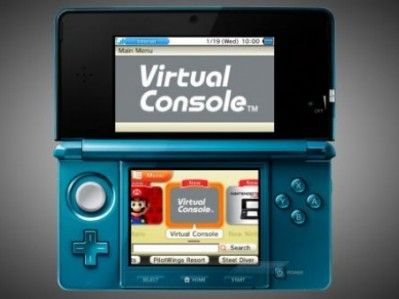
Sadly, it doesn’t seem as though N64 titles will reach the handheld
Whether or not every title will have full 3D gameplay is unconfirmed, though if Nintendo expects us to cough up more than €5 for a Game Boy title, they bloody well better. The as-yet unconfirmed inclusion of Game Boy Advance titles in the eShop could be a deal breaker for the store’s fortunes – a 3D version of GBA classic Advance Wars thrills us a lot more than bright-green Game Boy Tetris offering.
Battery Life
By far the biggest issue with the burgeoning handheld. On full brightness, using full 3D throughout, the 3DS only lasts 3 hours, while the console takes 3 hours and 30 minutes to charge back to full power.
We understand that many of you might charge your smart phones on a daily basis, but for a handheld whose main selling point is 3D, the fact most users may be wary of using it in order to conserve battery life is simply unacceptable. Unfortunately, for camping trips or long bus journeys, the current 3DS model cannot be called a truly portable device.
3D Effect
Whether or not 3D technology is the future of entertainment or a quick fad is yet to be determined, though from a graphical standpoint, it really helps the 3DS, whose graphics are at their best, reminiscent of a Wii titles (Pilotwings Resort) and at their worst, no better than an early PSP release (Ridge Racer 3DS).
The 3D slider is an utterly essential inclusion, as many of us in the JOE office have experienced vastly different tolerance to the 3D effect, while the effect itself differs for each title. A purely 2D fighter such as SFIV or a title that uses first-person views (Nintendogs + Cats) suffers little from a full blast of 3D, while more complex titles that require constant camera control such as Pilotwings Resort beg for a 3D dialling down.
Software Launch Lineup
The 3DS lineup is nothing if not eclectic, offering everything from football sims (Pro Evolution Soccer 3D) to spy thrillers (Splinter Cell 3D), though many would argue that there is no absolute ‘must-have’ title among this weekend’s 14 releases. In truth, it’s hard to argue – our favourite titles at a recent hands-on event were The Legend of Zelda: Ocarina of Time 3D and Kid Icarus: Uprising, both of which are set for as-yet unannounced Summer launches.
From what we have played, Super Street Fighter IV: 3D Edition is the most polished and content-heavy title on offer, while Pilotwings Resort, though light on content, is the most graphically impressive. Critics have also been kind to strategy title Tom Clancy’s Ghost Recon: Shadow Wars and Nintendogs + Cats, so there really is something for everyone. Just don’t be expecting an astonishing launch title game-changer, such as Halo: Combat Evolved on the original Xbox or Super Mario 64 for the Nintendo 64, or else you may feel a little short-changed.
Summary
Much like the original DS, Nintendo have released a hugely impressive console that is stacked with diversionary features that we expect will shortly become fully utilised in future must-have releases. With a greater focus on online content (just requiring one Friend Code, rather than game-specific codes is a godsend), smart usage of Miis and genuinely groundbreaking use of augmented reality, the same amount of care that has been made to the 3DS’ hardware and build has been afforded of its software.
We won’t lie and pretend the battery life is something we’re happy with, however – for a handheld console it’s pitifully inadaquate, while DSi XL users might wonder why they should have to play on a smaller screen. These are valid complaints that doubtlessly will be amended in a year or two when a new 3DS model hits the shelves.
If anything though, the greatest compliment we can pay Nintendo is that their focus on fun features and persuasive use of stunning glasses-free 3D renders the above complaints much less of a nuisance as they should be. Come the launch of Ocarina of Time 3D, resistance for Nintendo’s latest wonder may be futile.
LISTEN: You Must Be Jokin’ with Conor Sketches | Tiger Woods loves Ger Loughnane and cosplaying as Charles LeClerc
